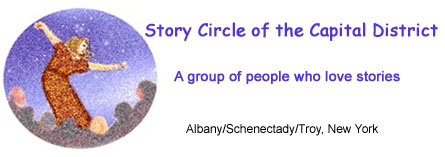
|
2025 Meetings
We will be meeting at:
Click here for our facilitator guidelines. A Process for Critical Response To guide our responses to stories told at our meetings, we are using the following coaching method, provided by West Virginia storyteller Granny Sue Holstein. Granny Sue highly recommends it to storytelling guilds for improving and strengthening a tellerís performance. The Four Part Coaching Process 1. Listening: Close, attentive listening that shows the teller that he/she has complete attention. This is displayed as body language and facial expression that reflects the active listening process. 2 Appreciations: Given only when the teller request them. These can be global (I love the way you tell that story) to specific (You projected that childís confusion so well). Appreciations end when the teller signals that he/she has heard enough. 3. Suggestions: Given only when the teller requests them. Suggestions are notcritiques or criticisms. they offer an idea the teller might want to try (Have you thought of......), note a reaction to the story (I didnít understand the part where.....), or ask a question to clarify a point (Why was the mother so angry?). Most importantly, all suggestions must be positive. The teller decides which to accept, reject or save for later consideration. 4. Wrap-Up: The tellerís opportunity to ask questions of the listeners about the story. (Was that part clear to you?), or anything else the teller might want to know. An important element of the process is that the teller decides when the process stops. For example, the teller could opt to stop after appreciations, or anywhere else in the process. The teller is in control, assisted by the facilitator. All present must be ďactiveĒ listeners for the process to work effectively. To be added to our e-mail list, for more information, or for comments, please call (518-383-4620) or write to us. |
